October, 2018

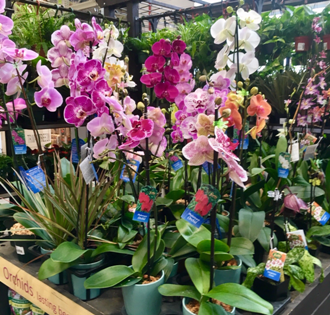
Grocery Store Orchids:
An interesting article by Atlas Obscura traces the history of the "Grocery Store Orchid", a marvel of biological research and technology, and now a multi-million dollar industry worldwide. Were it not for the advent of inexpensive cloned orchids—the technology works for all the popular orchid genera except Paphiopedilum—, few of us would be be able to afford good quality plants that could otherwise only be propagated by division.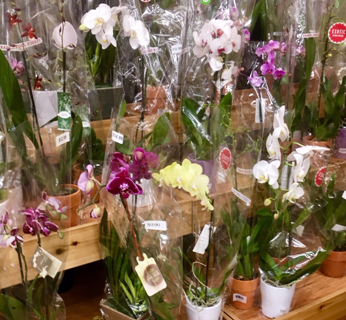
Not so long ago, buying an orchid plant required an all-day pilgrimage to an orchid nursery. Today, we can buy a pretty orchid on a whim, at almost any grocery store or home improvement store. Some garden centers also sell orchid plants, usually bigger or fancier, and at higher prices, to set themselves apart from the ordinary mass market.
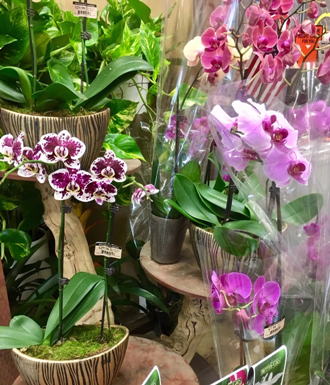
It is even possible to work out when the best plants will likely appear at Home Depot, and snap them up when they are fresh off the truck. Or, wait until they have finished blooming and pick them up for a reduced price. Many of the grocery store plants don't have labels, but some of the no-name orchids have turned out to be dependable plants with excellent flowers. Watch for an appreciation of our favorite no-name orchids in next month's column!
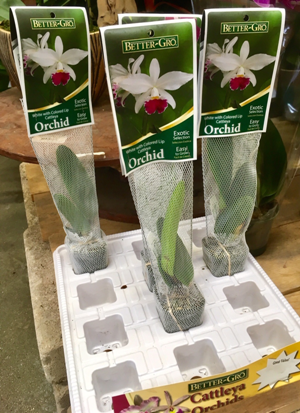
Occasionally, you may find a small selection of seedlings or mericlones in 2-inch pots, with complete labels, reasonably priced. It's worth taking a closer look at these. Some of the seedlings are from well-known or even awarded parents, and the plants are usually in good condition. Once we found a Dendrobium aggregatum seedling among these plants; it has grown into the nice specimen shown in our September, 2018 column.
All the accompanying pictures were taken within the space of an hour at stores in Long Beach on a Saturday morning.
Growing Orchids without a Yard or a Greenhouse:
How many of you live in an apartment or condo where you don't have access to a garden or patio where you can build a dedicated orchid habitat, let alone a greenhouse? Is it still possible to begin growing orchids in such a situation? The answer is an emphatic YES! Let's explore some of the possibilities.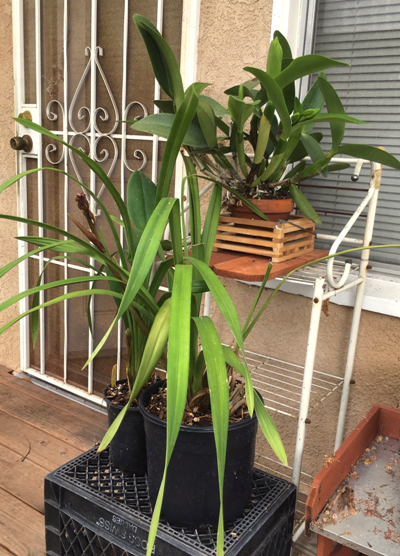
Back porch orchids in bud—
Come back next month for flowers!
Space, the Ante-Penultimate Frontier: How much space does it take to grow a few orchids? If you can also provide the appropriate temperature and humidity, and it you select the right kinds of orchids, you can get away with very tiny spaces. For growing indoors, orchids can be grown under lights, or on a windowsill. Outdoors, some orchids (not planted in the ground! — most orchids that beginners will encounter are epiphytes that belong in pots or mounted on a support of some kind) will do well on a patio, porch, or balcony. As long as you understand the temperature requirements of different kinds of orchids, inexpensive grocery store orchids, the kind you might receive as a gift, can survive and even thrive in a tiny space.
Temperature: Many orchids do best with warm days and cool nights, the same temperature conditions we experience outdoors for most of the year in Southern California. Cymbidiums fall into this category. They can adapt (gradually!) to nearly full sun and they have been known to survive and bloom after a hard frost. However, some of the more popular orchids (Phalaenopsis and Paphiopedilum, notably) can't handle our cold, damp winters at all — they respond by turning to mush —, and so must be grown indoors or in space that remains above about 50° F and out of the rain during the winter months.
Orchids are traditionally grouped into categories of cool, intermediate, or warm temperature requirements. These categories were originally developed in the era of large greenhouses, but the temperature ranges, especially the night temperatures, help us select an appropriate outdoor or indoor growing environment. "Warm growing" orchids do best when the night temperature is in the range of 65°-70° F; "intermediate growing" orchids prefer nights around 55°-65° F, and "cool growing" orchids are best adapted to nights around 50°-55° F. However, orchid hobbyists in our area continue to find that many species are far more tolerant than these numbers would suggest. One proviso to keep in mind, though, is that at least some orchids, along with many other types of plants, flower most easily when exposed to cool nights: a possible reason why an orchid grown indoors with a constant night temperature around 70° F fails to flower!
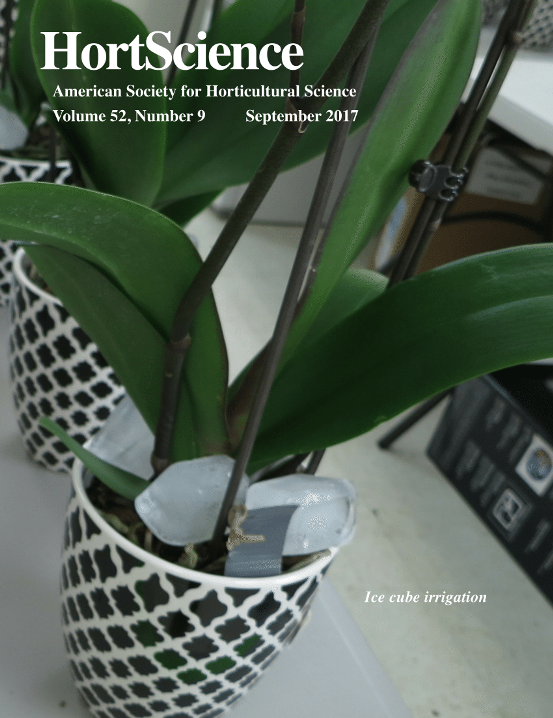
And you thought it was only a myth!
Humidity and Watering: Orchids need enough water to support growth and flowering, but excess water can easily lead to root rot. Without roots, orchids die. Also, water requirements change during the year. Many orchids have a distinct dormant season during which they are even more sensitive to over-watering. Over-watering probably kills more orchids than anything else.
There is even a sort of urban legend to the effect that Phalaenopsis should be watered with one ice cube per week — a strange idea, but easy to remember, and the plants don't seem to mind! In fact, the question was actually studied under controlled conditions, with the conclusion that "ice cube irrigation" did not decrease the time during which the flowers remained in good condition.
Where to Begin: For most people, the first orchid was something bought at a grocery store or home improvement store, or maybe it was a gift. After you have enjoyed the flowers for a few days, the question inevitably arises, "Now what? Will this thing grow in my house?" At that point, a good first step is to figure out what kind of orchid it is. Often it is a Phalaenopsis or perhaps a Cymbidium. Less frequently, it will be something related to Oncidium, an Epidendrum, or perhaps something even farther afield. All the common orchids are easily found on Google, and that is also the easiest source to find out what sort of growing conditions the plant wants. At least to start with, wait until the pot feels light, then water thoroughly. Don't let an orchid sit in water. If it's a Phalaenopsis, keep it indoors with filtered light (east window is usually a good choice, but avoid direct sun). Most of the other orchids that inhabit grocery stores will probably do well outdoors in warm weather, but they usually need to be adapted to outdoor conditions gradually, over a period of weeks, and most of them do not like full sun. They generally do better in dappled sun (under a few tree limbs for most of the day) or under shade cloth. Cymbidiums, in particular, are incredibly tough, but the leaves can be damaged if they sit in full sun on an extremely hot day.
Even better, attend the next meeting of South Coast Orchid Society and talk to a friendly bunch of orchid enthusiasts, all eager to get you started in a fascinating hobby!
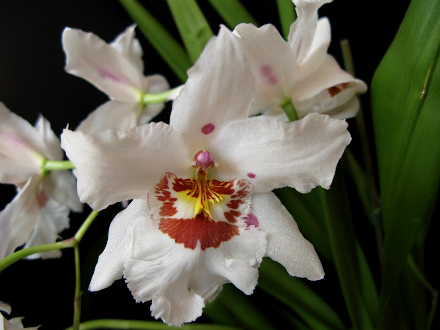
Odontonia (now Oncidopsis) Boussole 'Blanche'
Blast from the past: 1964
Probably the most important development in the history of growing orchids as a hobby took place around 1964 in the little suburb of Boissy-Saint-Léger, on the southeast side of Paris. There, the venerable firm of Orchidées Vacherot & Lecoufle, founded as a small nursery business by Henri Vacherot in 1886, but by the mid-1900's at the pinnacle of the orchid trade, achieved the mass cloning of Odontonia Boussole 'Blanche'.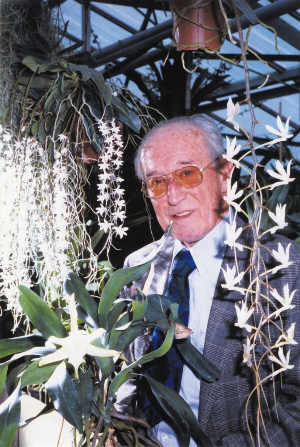
Marcel Lecoufle (1913-2016)
le pape des orchidées
The genius behind this development, the first nurseryman to apply the laboratory techniques that had been developed in the previous several decades to a commercial application, was Marcel Lecoufle (1913-2016), in his lifetime frequently known in France as the "Pope of orchids", but also a well-known expert on carnivorous plants, bromeliads, and other subjects. With the cloning of 'Blanche', it became possible for large numbers of people around the world to appreciate orchids of exceptional quality, and at a reasonable price. Vacherot & Lecoufle is still in business, and a large number of their older plants have become an official part of the French cultural heritage. You can find them on the internet and on Facebook.